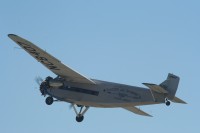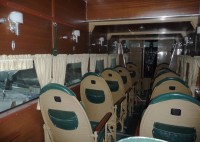 Having revolutionized individual transportation and industrial production with his Model T car, after World War I Henry Ford turned his sights to airplanes. He had been interested in aviation from its early days, lending three automobile factory workers to his 15-year-old son Edsel to help build a monoplane powered by a Model T engine in 1909, just six years after the Wright Brothers’ seminal flight at Kitty Hawk. Edsel’s Model T monoplane never did fly well and its brief life ended when it crashed into a tree. During the war, Ford applied his production genius to aircraft engines. In the fall of 1917, the War Department commissioned 22,000 12-cylinder Liberty engines from all of Detroit’s automotive companies. Ford redesigned the process for cylinder production, streamlining it so production rose from 151 cylinders a day to more than 2,000. In the end, Ford produced all of the Liberty cylinders (433,826 in total) and 3,950 complete engines.
Having revolutionized individual transportation and industrial production with his Model T car, after World War I Henry Ford turned his sights to airplanes. He had been interested in aviation from its early days, lending three automobile factory workers to his 15-year-old son Edsel to help build a monoplane powered by a Model T engine in 1909, just six years after the Wright Brothers’ seminal flight at Kitty Hawk. Edsel’s Model T monoplane never did fly well and its brief life ended when it crashed into a tree. During the war, Ford applied his production genius to aircraft engines. In the fall of 1917, the War Department commissioned 22,000 12-cylinder Liberty engines from all of Detroit’s automotive companies. Ford redesigned the process for cylinder production, streamlining it so production rose from 151 cylinders a day to more than 2,000. In the end, Ford produced all of the Liberty cylinders (433,826 in total) and 3,950 complete engines.
(Fun fact: Cadillac initially declined to build Liberty engines because General Motors co-founder William C. Durant was a pacifist. Henry M. Leland, creator of the Cadillac company who had sold it to GM in 1909 but stayed on the payroll as an executive, wanted in on the Liberty order, so he left General Motors and founded Lincoln solely to produce the airplane engines. It was only after the war that the Lincoln plant turned to automobile production, using a luxury V8 engine inspired by the design of the Liberty. Ford bought Lincoln in 1922, streamlined operations to make it profitable, muscled Leland out within months and to this day Ford Motor Company still produces luxury cars under the Lincoln imprint.)
It wasn’t until 1923 that Henry Ford dipped his toe into commercial aviation by investing in William Bushnell Stout’s Stout Metal Airplane Company. Henry and Edsel invested $1,000 each in Stout’s company which went on to produce the Stout 2-AT “Air Pullman,” the first all-metal single engine monoplane. That single engine, by the way, was a Liberty. In April of 1925, the Ford Air Transport Service, the first regularly scheduled commercial airline, went into operation carrying 1,000 pounds of freight aboard an Air Pullman between Detroit and Chicago. In August of 1925, Henry and Edsel purchased the Stout Metal Airplane Company outright and created the Stout Metal Airplane Division of the Ford Motor Company.
 To get the word out and assure potential customers that air flight was a dependable means of transporting cargo, Ford launched the Ford National Reliability Air Tour with the Air Pullman as its featured player. The tour was effective and less than a year after that first cargo flight, Henry Ford and William Stout accompanied the first bag of air mail to be carried by a commercial flight from Detroit to Cleveland under escort of fighter planes.
To get the word out and assure potential customers that air flight was a dependable means of transporting cargo, Ford launched the Ford National Reliability Air Tour with the Air Pullman as its featured player. The tour was effective and less than a year after that first cargo flight, Henry Ford and William Stout accompanied the first bag of air mail to be carried by a commercial flight from Detroit to Cleveland under escort of fighter planes.
While the 2-ATs went to work delivering mail, Stout went to work on a new model: the 3-AT trimotor, an all-metal craft with three engines (originally Liberties until they proved too heavy and were replaced with Wright J-4 engines) and a large passenger or cargo compartment. Ford thought the 3-AT was the future of aviation until he saw the test flights. They were abject failures and Henry barred Stout from the engineering room after that.
Sans Stout, the Stout division of Ford started over after a fire destroyed all their 2-ATs and the prototype 3-AT on January 16th, 1926. They updated the 3-AT design to create a trimotor that was actually able to maintain altitude and the Ford 4-AT Trimotor, aka the “Tin Goose,” was born. Designed for passengers but with removable seats for cargo transport, the sturdy metal plane was an immediate success. It would become the first mass-produced passenger airplane with a total of 199 manufactured between 1925 and 1933. In 1927, Pan American used Trimotors for its first international flights from Key West to Havana, Cuba. Transcontinental Air Transport, with routes and airports designed by Charles Lindbergh, used Ford Trimotors to carry passengers coast to coast (albeit with train legs in between) in 1929. The next year it merged with Western Air Express to create TWA. Franklin Delano Roosevelt flew a Trimotor during his 1932 presidential campaign, replacing the traditional train whistle stop tour.
Its heyday was brief as new technology superseded the Trimotor by 1933, but the plane still flew for decades. Trimotors were used as sightseeing planes, barnstormers, crop dusters and to carry freight to remote mining operations far from city airports. One particularly heroic Trimotor transported 50 people a day off the island during the 1942 Battle of Bataan until Japanese fighters shot it out of the sky.
There are 18 Trimotors still in existence today, eight of which are airworthy. One of them, a 4-AT-E model built in 1929 for Eastern Air Transport, is owned by the Experimental Aircraft Association out of Oshkosh, Wisconsin, which spent 12 years putting it back together after the plane was lifted up by a gust of wind and slammed into the runway. That model is now touring the country giving nine people at a time the full 1929 experience in its restored cabin.
This weekend it’s in Waco, Texas, at the McGregor Executive Airport.
You can’t book online anymore for this weekend’s rides, but you can still get walk-up tickets, $75 for adults, $50 for children 17 and under. The plane will be in St. Simons Island, Georgia, next weekend and Savannah, GA, the weekend after that. The final flights of the year will take place the weekend of November 14th in Jacksonville, Florida.
I would LOVE to ride that plane! Too bad I’m north with winter coming, or I’d be there. Maybe it’ll make its way to New England eventually.
I booked a flight on a tri motor at ocean City MD around 1988-89, We flew up and down the beach,, fantastic, We recieved a little certificate and a lapel pin of a tri-motor
I flew on that aircraft in Ocean City. I lost the pin and certificate
I have my grandmother’s certificate from July 13, 1929 with the plot’s name (apt. O. M. ….dsell, H.C. 7121. I’m wondering if it’s valuable.